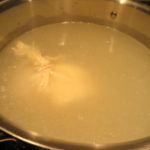Parmesan Broth
It’s time to start saving your Parmesan rinds. You paid good money for them, so you might as well capture their captivating cheese flavor. Yes, in that hard rind lies enticing flavors. We just need to encourage them to release all they have to give. You begin by freezing your rinds in an airtight container or plastic bag. Once you have a ¼ pound (or about ½ a cup) you can begin. This will yield about 3 cups of broth. I wrote the recipe for ½ pound of rinds. Cut it in half or double the recipe if you have more or less rinds. The longer you cook it and the more rinds you use will create a deeper flavor. Freeze the stock, making it available whenever you’re ready to use it.
Now, here’s the fun part. There is so much you can do with it. Use it in place of or in combination with vegetable or chicken stock. Here are a few ideas.
Soups
Risotto
Polenta
Beans
Replace water in a bread recipe
Stuffing
Deglazing a pan, creating a Parmesan flavored sauce
Braising vegetables or chicken
You can use a variety of aged cheese for this broth. Parmesan Regianno, Grana Pradano, Pecorino Romano and Asiago. They are similar yet each is unique to the regions in which it is made. Each of these regions have very specific guideline for the cheese that bares their name. They stamp the cheese with a symbol defining their “Designated Point Of Origin”. All are made with cow’s milk except Pecorino, which is made with ewe’s milk. You don’t have to limit your rind collection to these Italian cheeses. I love the caramel and butterscotch flavors of an aged gouda. You could also save rinds from aged provolone, cheddar or montereey. Each will impart an additional, lovely, layer of flavor to your broth. DO NOT USE ANY RIND WITH A WAX COATING.
Parmesan Broth
Ingredients
- 1 cup Parmesan rinds about ½ pound
- 8 cups Water
- cheesecloth
Instructions
- Wrap rinds in cheesecloth, tying the top with butcher string. In a saucepan, pour in 8 cups water. Add the bundled rinds. Bring to a boil. Reduce to a simmer. Simmer for 1 ½ to 2 hours. Stir occasionally, to ensure cheese does not stick to the bottom of the pan.
- Refrigerate the broth overnight. The fat will form a thin layer on top of the broth. This can be easily removed with a large slotted spoon. Refrigerate the broth for up to seven days or freeze for up to three months.
Notes
Risotto with Spinach & Thyme


